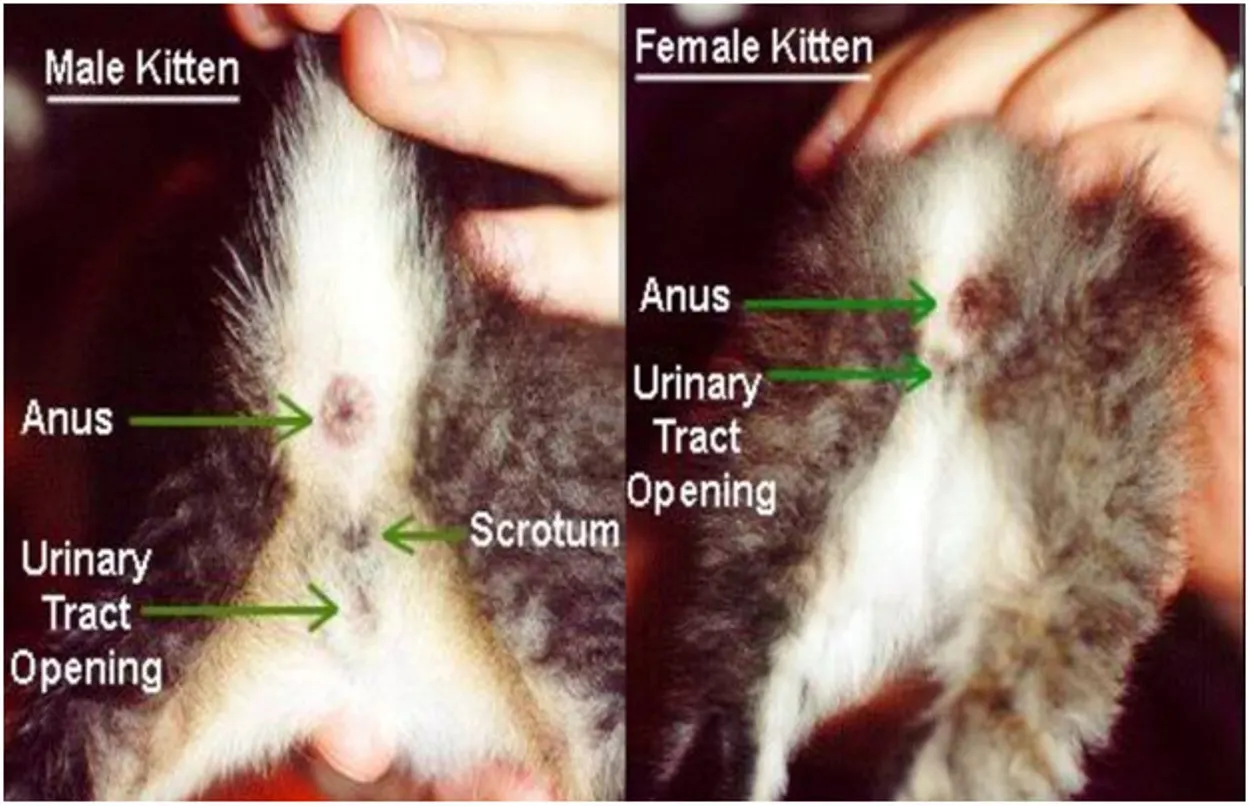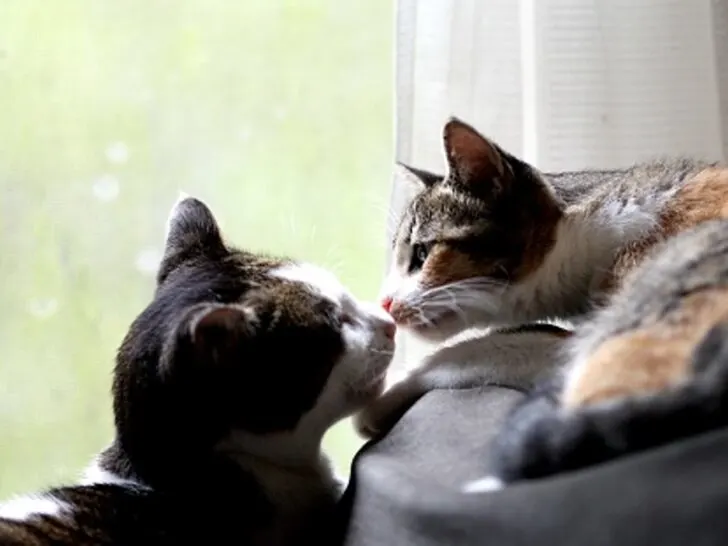Suppose you have a kitten and are thinking of giving it a name but are unaware of its gender. It is important to know your cat’s gender before naming them. You might think that determining cat gender is easy, but it can be tough when they are very young.
When the cat is older than five or six weeks, it becomes easy to determine whether it is male or female. It can be daunting to determine the gender of a cat at times, especially when there is no other cat available for the anatomy comparison.
There are a few ways to determine the gender of a cat. If your cat is friendly or you have built a good relationship with the cat, pick them up and lift its tail. Scratch the cat where the lower back meets the tail if it isn’t elevating its tail. Most of the cats lift their tail by doing this trick to them.
Once the cat’s tail is up, you can fully view the cat’s anus and genitals. The main difference between males and females is the gap between the anus and genitals. A male cat has a huge gap between the anus and genitals than females.
Over 1 inch apart on an adult male kitten or ½ inch on a male kitten. Suppose the gap is less than ½ inch; it’s a female cat. Other than the shape of the genital and spacing, you can use different clues such as coat color to find out the gender of the cat.
The behavior of cats can also play an essential role in determining their gender. There is a vast difference between male and female kittens.
Let’s get an insight into this article.
Cautious Handling
It is important to take care of a few things while determining the gender of a kitten. First, be patient and do not disrupt the mother-kitten flow at the start of a few weeks of life. Disruption will lead to the mother leaving the kitten and not nursing it. So it is important to keep yourself calm about the kitten’s gender.
The wise decision would be to wait for at least two to three weeks. When assessing the kitten’s gender, the minimization of stress is very necessary.
Start by petting them, picking them up gently, and snuggling them close to yourself. By doing these acts, you will gain the trust and friendliness of the kitten, which will lead to the ease of revealing the gender.

Some breeders liken the appearance of the kitten’s genitalia to a punctuation mark at two weeks old. The genitals of female kittens will resemble a point of upside-down exclamation, with the vertical vegetal slit sitting just below the anus and with very little spacing in between.
The organs of a male kitten look more like a colon, with the penis residing just below the anus and separated by enough gap to accommodate his testicles. There are small lumps in that gap which will grow as the kitten get ages.
Through visual observation, all the kittens look the same. You must pick one and softly place your finger and thumb on both sides of the scrotum area.
You can feel two small, hard, oval-shaped objects under the skin. They are called testes, and it is unlikely to hold them. They slither away underneath your fingers. It is obvious if the testes are present, your kitten is a male.
Coat Color
Here is another simple way to determine the gender of the kitten. But it is less reliable. From the color, we can determine a kitten’s gender by its coat.
Tri-colored or tortoiseshell cats are often female. The female cat’s chromosomal makeup is solely responsible for this coloration, so you can be sure every calico cat is a female kitten.
Ginger or orange-colored cats are mostly male. But this trait is not reliable as compared to the tri-colored trait. Ginger-colored cats are male only three-quarters.
Determine Through the Behavior
As kittens become mature, they start to adopt their different personality traits. For example, a male cat will begin to roam as they approach sexual maturity. They mark their territory by spraying to establish their home base. Males may also be more aggressive and restless when the female kitten reaches a mature age.
They approach the different styles to show their sexual approach through loud yowls and attention-seeking behavior. Some people believe male cats are friendlier and more outgoing than female cats. Female cats have more attitude, and they are not easygoing.
But it is not utterly true as every cat has a unique personality and different personality traits, which can vary from one cat to another, whether it is a male or female kitten.

The Physical Difference Between Male and Female Kittens
- Male cats are usually bigger and heavier than female cats, especially when they are not neutered until after sexual maturity.
- Due to testosterone, unneutered male cats developed big cheeks and large round faces than female cats. Prominent cheeks signify a male cat’s fitness for the other female and male cats.
- The cat may retain this quality to a certain extent after being neutered. On the other hand, female kittens have more advantages over male cats. Such as, female cats open their eyes earlier than male cats, which allows them to see the world earlier.
- At 7-12 months, females reach sexual maturity earlier. Female cats are likely to live longer than male cats.
- Unfortunately, there is also a major physical disadvantage for male cats. Due to the smaller urethra, male cats are more prone to urinary obstructions than females.
- This can lead to many problems, such as urinary tract infections. Issues like this lead to repeat trips to the veterinarian, and to reduce the development of urine crystals, a special diet to feed is very important.

Let’s have a look at the following distinctions in tabular form.
| Characteristics | Female Cat | Male Cat |
| The gap between the anus and genitals | It has a small gap | It has a large gap |
| Genitals Resemblance | Resemble an upside-down exclamation mark, with the vertical vegetal slit immediately below the anus and very little space in between | A male kitten’s organs resemble a colon, with the penis located directly below the anus and separated by a sufficient gap |
| Size | Smaller and thinner than males | Bigger and heavier than females |
| Behavior | Neutral | More aggressive |
The Time When You Can Tell a Cat’s Gender
There isn’t any perfect time for determining and telling a cat’s gender. However, it’s recommended to remain patient and not hurry to find out right after birth. Moreover, it’s difficult to gain information about gender until three weeks.
The reason is that the external genitalia aren’t fully grown yet, and female kittens look much like male kittens. The common practice is that after the cats become 8-10 weeks old; then it becomes easier to figure out their gender.
Speaking of cats, have you ever wondered what the difference is between leopard and cheetah prints? Check out my other article for everything you need to know.
How to Treat Younger Kittens to Check Their Gender?
Always treat them with kindness. Never try to be harsh with them. Checking the organs of kittens under eight weeks is far more challenging because the organs you are looking at are tiny and underdeveloped.
Fortunately, kittens this young should still be with their mothers and litter mates, and comparing same-aged animals can help you identify what male and female kitten anatomy look like.
It’s good for them to stay with their mates, to play with them, and enjoy their early age. All the preceding guidelines apply but don’t over-stress young kittens by taking them from their mother for more than five minutes at a time, as well as litter mates.
Be kind and gentle to the animals. They are beautiful creatures. Therefore, always behave well with your pets.
Can You Determine the Gender Through Nipples?
Do male cats have nipples? Well yes. But by this, you cannot easily tell the gender of a kitten because it is a point of discussion when they are grown up and become parents. The female cat feed milk to their children.
So at an early age, you cannot identify through this feature.
Conclusion
- There are different ways to determine the kitten’s gender. But the most reliable is to look down at their reproductive organs.
- A female kitten’s anus is straight. The genitalia of a male kitten, on the other hand, will appear more rounded.
- A kitten’s behavioral features and coat colors also play an important role in determining the gender of a cat.
- However, aside from the decision to spray or neuter, they don’t have much to give. It is important to choose the kitten you feel connected with, regardless of gender.

